
Electronic english version since 2022 |
The newspaper was founded in November 1957
| |
Projects of the XXI century
The anniversary of DNA brought together
radiobiologists and geneticists
On 19-20 October, the International Conference "Current Problems of Radiation Biology. Molecular and genetic research in radiobiology dedicated to the 70th anniversary of the discovery of the structure of DNA" was held in Dubna.
April this year marked 70 years since publication of the article by J.Watson and F.Crick in the journal Nature, in which a model of the spatial structure of DNA, a double helix was first proposed. This discovery was made possible due to the interaction of physics, chemistry and biology and marked the beginning of the incessant development of new areas. Radiation biology makes a significant contribution to molecular and genetic research. The Conference was organized by the Scientific Council on Radiobiology of the Russian Academy of Sciences, the Radiobiological Society of the Russian Academy of Sciences and LRB JINR. The specialists from research centres and universities in Moscow, St. Petersburg, Obninsk, Pushchino, Tomsk, Sarov, Ozersk, Azerbaijan, Armenia and Belarus took part in the mixed-format Conference.
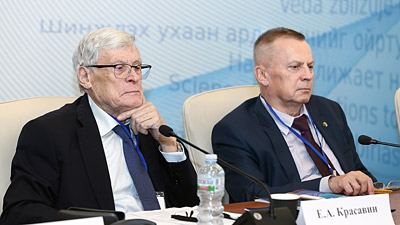 |
| E.A.Krasavin and I.B.Ushakov |
The programme of the Conference is structured in such a way that the reports will reflect various aspects of this issue. First of all, these are mutation investigations, the report of Professor A.V.Boreyko "Radiation mutagenesis and accelerated heavy ions" is dedicated to them. The accelerators of our Institute that successfully operate for physics, also operate successfully for biology: first of all, these are the DLNP phasotron that has been operating for many years and the multiply charged ion accelerators of FLNR. The new NICA project will allow us to penetrate into the depths of those mechanisms that determine subtle biological phenomena. I think that in all the reports of the Conference we will quite completely cover the issues of radiation genetics and mutation processes."
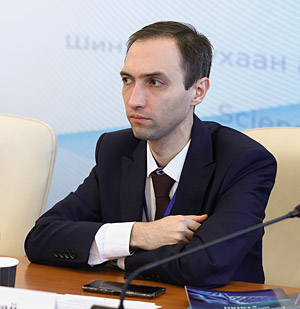 Director of the Laboratory A.N.Bugay spoke in more detail about the reports prepared by LRB staff members:
Director of the Laboratory A.N.Bugay spoke in more detail about the reports prepared by LRB staff members:
"A number of well-known specialists are participating in the Conference, lectures will be given, sectional reports will be made and young people will give poster presentations. Reports on the structure of molecular DNA damage, the characteristics of their repair, induced mutations, the genetic, structural and long-term consequences of radiation concerning radiation therapy and various radiation incidents will be presented.
At the plenary sessions, there will be speeches dedicated to fundamental issues of the origin of matter. The papers of our laboratory are widely presented, reports are given by leading experts, doctors of science. There will be reports on molecular radiobiology, a lot of investigations on various types of DNA damage, radiation-induced mutagenesis, cytogenetic effects of ionizing radiation and various aspects of simulation of these processes will be presented. A number of messages are related to the effects of radioprotectors and there are also a number of fundamental things related to quantum information on DNA, even such an exotic fundamental area is presented here."
Welcoming the participants of the Conference, Director of the Joint Institute Academician of the Russian Academy of Sciences Grigory Trubnikov said: "It is a great honor for us to welcome here senior comrades and good friends from legendary organizations, such as Moscow State University, FMBC named after A.I.Burnazyan, Institute named after A.F.Tsyb, other universities, the Russian Academy of Sciences represented by the Council on Radiobiology. The anniversary is a very good occasion to talk about current issues not only in genetics, but also in molecular biology, radiation biology and other areas. Thanks to the Department of Physiological Sciences of the Russian Academy of Sciences and LRB for organizing this event with maximum human participation."
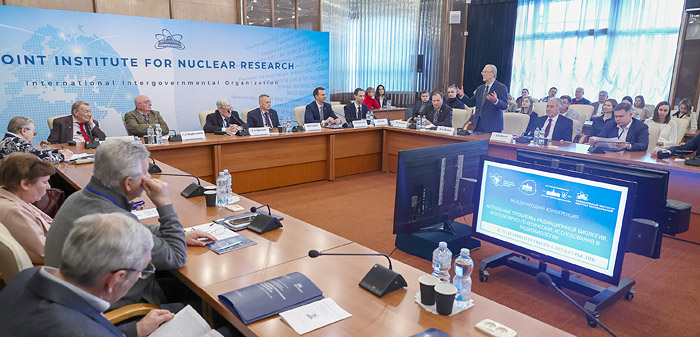
JINR Scientific Leader Academician Victor Matveev emphasized: "It's wonderful when both biologists and physicists gather in one hall. Then the proximity of beginnings is revealed: nuclear physics is looking for the beginning of the Universe and biology is looking for how life started on Earth. Such a meeting stimulates progress in the investigation of the fundamental laws of our world." The participants of the meeting were also greeted by JINR Vice-Director Professor Latchesar Kostov.
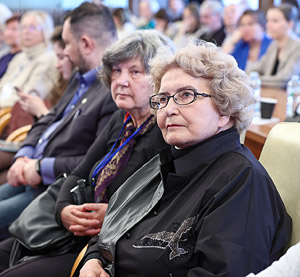 E.A.Krasavin announced a minute of silence in memory of RAS Academician, radiation hygiene specialist, one of the organizers of the Institute of Biophysics of the USSR Ministry of Health L.A.Ilyin that passed away on 7 October. In his opening remarks, Evgeny Aleksandrovich named the Russian scientists on whose discoveries modern researchers rely. This is G.A.Gamov, a Soviet and American theoretical physicist that first addressed the issue of the genetic code. He proposed in 1954 that hereditary information should be encrypted in a sequence of triplets of four nucleotides. Professor V.I.Korogodin started biological research at JINR in 1967, he had previously discovered the effect of post-radiation recovery in yeast cells. V.P.Paribok, V.D.Zhestyannikov, N.V.Tomilin stood at the origins of Russian molecular and radiation biology. A world-class specialist in this field, molecular biologist Professor S.E.Bresler was G.N.Flerov's classmate, he visited JINR and collaborated with FLNR. An outstanding specialist in the field of DNA damage repair Professor A.I.Gaziev has recently passed away.
E.A.Krasavin announced a minute of silence in memory of RAS Academician, radiation hygiene specialist, one of the organizers of the Institute of Biophysics of the USSR Ministry of Health L.A.Ilyin that passed away on 7 October. In his opening remarks, Evgeny Aleksandrovich named the Russian scientists on whose discoveries modern researchers rely. This is G.A.Gamov, a Soviet and American theoretical physicist that first addressed the issue of the genetic code. He proposed in 1954 that hereditary information should be encrypted in a sequence of triplets of four nucleotides. Professor V.I.Korogodin started biological research at JINR in 1967, he had previously discovered the effect of post-radiation recovery in yeast cells. V.P.Paribok, V.D.Zhestyannikov, N.V.Tomilin stood at the origins of Russian molecular and radiation biology. A world-class specialist in this field, molecular biologist Professor S.E.Bresler was G.N.Flerov's classmate, he visited JINR and collaborated with FLNR. An outstanding specialist in the field of DNA damage repair Professor A.I.Gaziev has recently passed away.
President of the Radiobiological Society of the Russian Academy of Sciences I.B.Ushakov (FMBC named after A.I.Burnazyan) began his greeting with memories, saying that from the very beginning of the Soviet space programme, geneticist N.L.Delone that turns 100 years old on 4 November, participated in it. For our weekly, Igor Borisovich noted:
"The Conference that has just started is of great interest to all radiobiologists. Our RAS society unites about a thousand researchers in various fields of radiobiology, this is about 20 separate areas. Among them, there are radiation geneticists and molecular biologists, yet all radiobiologists from other areas take into account and apply the techniques of molecular genetic research. Perhaps in the future, radiogenomics will be highlighted, the area of radiobiology that is already searching for markers of radiosensitivity and radioresistance for various people that are exposed to radiation in high doses. First of all, it concerns radiation therapy fields, astronauts and liquidators of the consequences of radiation accidents that occur and that must be taken into account as a possible dangerous factor. These areas allow to provide also practical medicine with these markers and in many ways, the reports are dedicated to these areas."
In your speech, you have mentioned the "Cosmonaut genome and epigenome" programme...
"As for this programme, it was developed in 2014, signed by the Institute of Medical and Biological Problems and the Institute of General Genetics, but afterwards, research on it was not specifically funded, although some work is underway. By reminding that such a programme existed, I wanted to attract and captivate researchers with these issues.
An astronaut is a special category of people that are exposed to increased radiation risk. Suffice it to say that radiation exposure levels on the ISS are 200 times higher than on Earth and a significant dose accumulates over a year at the station. These issues need to be addressed and we hope that the Conference will draw attention to this important point, for which many scientists from various research institutes are already ready."
 Academician of the Russian Academy of Sciences A.Yu.Rozanov (Palaeontological Institute of the Russian Academy of Sciences, LRB JINR) welcomed the participants:
Academician of the Russian Academy of Sciences A.Yu.Rozanov (Palaeontological Institute of the Russian Academy of Sciences, LRB JINR) welcomed the participants:
"There are a few places left in our country where science is treated with care. Dubna is one of them and it's always a pleasure for me to be here. A general friendly atmosphere and respect for fundamental science are very important. All JINR Directors understood this.
And if we want to preserve the state, then it must necessarily support fundamental science, for this is the only way to really get ahead. If we focus only on import substitution and very important, necessary and useful work in applied science, then we will always be catching up. Of course, it's impossible to improve everything in one day that means we need to focus on the fact that at least 20 years from now we must systematically and calmly improve it. The main task for us today is to make every effort so that the attitude towards fundamental science in our country changes in a positive side."
For our weekly he added:
"I am not a specialist in the field of genetics, I am a geologist by training, I have worked for two terms as Academician-Secretary of the Department of Biological Sciences of the Russian Academy of Sciences. I am interested in space research. We have published at JINR the world's first atlas of fossils found in the Orgey meteorite and it caused a sensation in the USA. Currently, we have finished the book. It will be the first manual on astrobiology in our country and with such coverage of matter - the first book in the world. We are going to translate it into English."
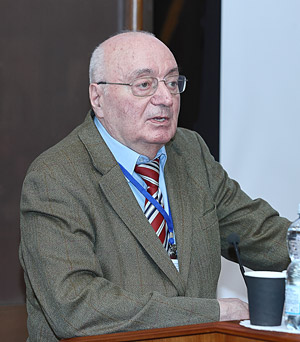 "Dubna was, is and will be an adornment of Russian and Soviet science, it is a stunning, important place for the country, it is the pearl of the country," Corresponding Member of the Russian Academy of Sciences S.D.Varfolomeev (Institute of Biochemical Physics of the Russian Academy of Sciences, Moscow State University) greeted the participants of the Conference. "Here is a highly intellectual centre that allows itself to meet such fundamental issues, the significance of which we may understand in hundreds of years."
"Dubna was, is and will be an adornment of Russian and Soviet science, it is a stunning, important place for the country, it is the pearl of the country," Corresponding Member of the Russian Academy of Sciences S.D.Varfolomeev (Institute of Biochemical Physics of the Russian Academy of Sciences, Moscow State University) greeted the participants of the Conference. "Here is a highly intellectual centre that allows itself to meet such fundamental issues, the significance of which we may understand in hundreds of years."
He gave a lecture "The thermal cycle is the driving force of prebiological synthesis and selection of biopolymers, the basic basis of the origin of life," the essence of which he explained to our readers:
"To understand the origin of life, it is necessary to find out how self-replicating polymer molecules occurred, because life is a way of existence of polymer bodies. We need to come up with mechanisms that would allow them to occur and self-reproduce in the lack of enzymes, DNA molecules and RNA molecules. The explanation is that there are the only physical conditions that cause polymer molecules to be synthesized if there is water. All polymers known to us in nature are products of polycondensation, a process in which water molecules are produced. According to thermodynamics, polymers cannot be produced in water, since an excessive concentration of water will simply destroy them.
The main idea of the concept is that it is only possible if water passes into the gas phase. At temperatures above the phase transition, we observed the synthesis at gigantic rates of phosphodiester bonds, if it is DNA, RNA, amide bonds, if it is a protein molecule. A natural cycle may be the daily cycle of the Earth, when under primary conditions, at very low atmospheric pressure, water evaporated already at 30°C. In case, the same place on the surface was moved into the shade when the temperature dropped to -10°C, the water condensed and the same droplet became a solution of monomer and polymer. And if this resulting monomer has a negligible advantage, then in a million years, that is 365 million thermal cycles, you will get 100 percent of these monomers. A derivative of this is the most obvious thing that the three most important polymer substances: peptides, proteins, RNA and DNA could occur in an independent version. As soon as they found each other, a powerful competitive advantage occurred: protein became a catalyst, RNA became a molecule that transmits information, DNA was frozen, only RNA can interact with it. The key factor here is the very large number of cycles. Life emerged one and a half billion years after the development of the solar system. For one and a half billion years, the system evolved at the macromolecular level; it naturally synthesized molecules with certain properties. And the competitive advantage is that the complexes are more stable from the point of view of physical chemistry and are easily hydrolyzed. And this can be verified experimentally.
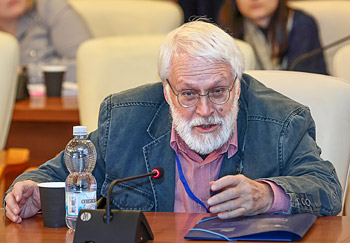 N.N.Khromov-Borisov gave a lecture "Evolution and drama of ideas about the molecular nature and reproduction of genes and chromosomes" at the Conference, outlining the history of ideas about the molecular nature of genes, recalling the iconic figures of this history and the fundamental principles. And for our weekly he told:
N.N.Khromov-Borisov gave a lecture "Evolution and drama of ideas about the molecular nature and reproduction of genes and chromosomes" at the Conference, outlining the history of ideas about the molecular nature of genes, recalling the iconic figures of this history and the fundamental principles. And for our weekly he told:
"I am a geneticist by training. My parents are chemists and this path was destined for me; I entered the Chemistry Department of Leningrad University. In our second year, my friend and I realized that we were interested in the science of genetics. It was banned then. It was in 1957 that the brilliant mathematician, rector of Leningrad State University A.D.Aleksandrov returned Professor M.E.Lobashev to head the Department of Genetics and Selection. We were lucky when having returned from potatoes, heard an announcement: Professor Lobashev was giving a lecture on what genetics is at the House of Political Education on the Moika. We went to the lecture, we were fascinated by him... He told us: come to the department and that's how it all began. We were allowed to study according to an individual plan and in parallel with our chemical education, we received a full education in genetics. This was the only department where real genetics was taught..."
Summing up the Conference at the final discussion, E.A.Krasavin said: "We completed our task with honor, dedicating the Conference to the 70th anniversary of the discovery of the structure of DNA. The reports were interesting and informative. It is very important that we examined the fundamental mechanisms of the mutation process, various aspects of the organization of the repair systems of DNA within cells and their exclusive role in the development of genome stability. I always emphasize the important fact that the field of biological sciences dealing with issues of DNA repair owes its birth and development to radiation biology." On behalf of the Council on Radiobiology of the Russian Academy of Sciences, he wished all his colleagues fruitful work and further scientific success.
Olga TARANTINA,
photo by Igor LAPENKO